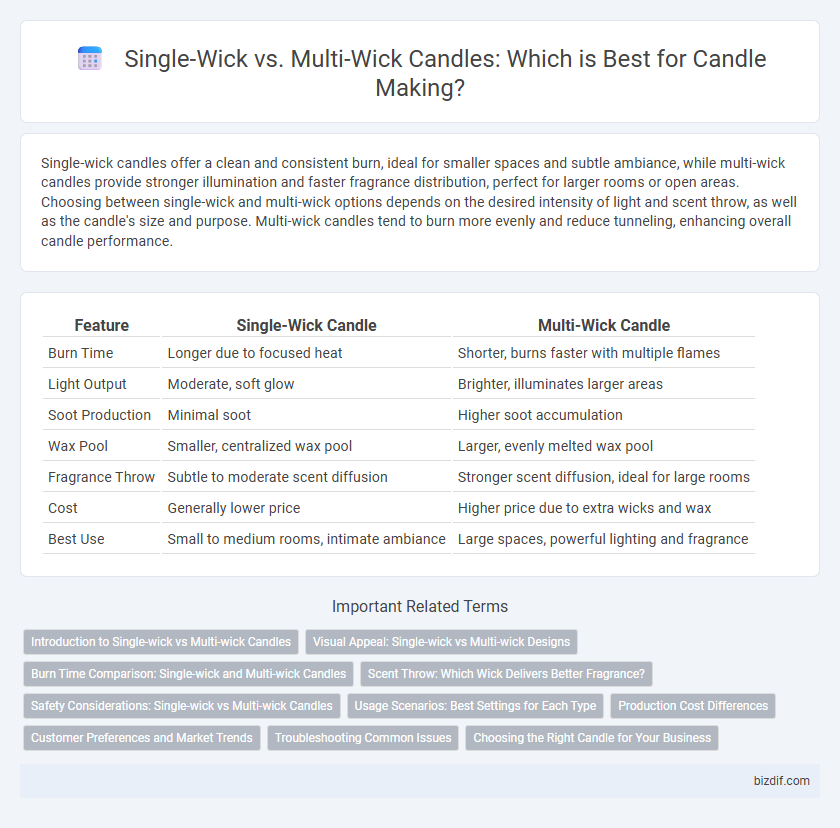Single-wick candles offer a clean and consistent burn, ideal for smaller spaces and subtle ambiance, while multi-wick candles provide stronger illumination and faster fragrance distribution, perfect for larger rooms or open areas. Choosing between single-wick and multi-wick options depends on the desired intensity of light and scent throw, as well as the candle's size and purpose. Multi-wick candles tend to burn more evenly and reduce tunneling, enhancing overall candle performance.
Table of Comparison
| Feature | Single-Wick Candle | Multi-Wick Candle |
|---|---|---|
| Burn Time | Longer due to focused heat | Shorter, burns faster with multiple flames |
| Light Output | Moderate, soft glow | Brighter, illuminates larger areas |
| Soot Production | Minimal soot | Higher soot accumulation |
| Wax Pool | Smaller, centralized wax pool | Larger, evenly melted wax pool |
| Fragrance Throw | Subtle to moderate scent diffusion | Stronger scent diffusion, ideal for large rooms |
| Cost | Generally lower price | Higher price due to extra wicks and wax |
| Best Use | Small to medium rooms, intimate ambiance | Large spaces, powerful lighting and fragrance |
Introduction to Single-wick vs Multi-wick Candles
Single-wick candles provide a steady and focused flame ideal for smaller jars or votives, offering even melting and longer burn times. Multi-wick candles, often featuring two or more wicks, deliver increased fragrance throw and a more intense glow suitable for larger containers or wide candles. Choosing between single-wick and multi-wick designs depends on desired burn performance, scent diffusion, and candle size.
Visual Appeal: Single-wick vs Multi-wick Designs
Single-wick candles offer a classic, minimalist aesthetic that emphasizes simplicity and elegance, ideal for softly illuminating small to medium spaces. Multi-wick designs create a more dynamic visual effect with multiple flames flickering simultaneously, producing stronger ambient light and intricate shadow patterns perfect for larger areas. The choice between single-wick and multi-wick candles significantly impacts the decorative ambiance, influencing both brightness intensity and flame movement within the room.
Burn Time Comparison: Single-wick and Multi-wick Candles
Single-wick candles typically offer longer burn times due to their slower, steady flame consuming wax evenly. Multi-wick candles burn faster as multiple flames collectively consume wax, resulting in shorter overall burn duration. Choosing between single-wick and multi-wick depends on desired burn time and intensity of fragrance release.
Scent Throw: Which Wick Delivers Better Fragrance?
Single-wick candles often provide a more concentrated and consistent scent throw due to the controlled wax pool around a single flame, enhancing fragrance diffusion. Multi-wick candles release a stronger and more intense scent throw by creating multiple hot spots that melt the wax faster, increasing fragrance evaporation rate. For larger spaces, multi-wick candles generally deliver better fragrance distribution, while single-wick options are ideal for smaller areas or subtle scent ambiance.
Safety Considerations: Single-wick vs Multi-wick Candles
Single-wick candles generally present fewer safety risks due to a smaller flame size and lower heat output compared to multi-wick candles, which can produce larger, more intense flames. Multi-wick candles increase the risk of uneven melting and wax overflow, potentially causing burns or fire hazards if left unattended. Proper placement away from flammable materials and regular monitoring are essential safety precautions for both single-wick and multi-wick candle use.
Usage Scenarios: Best Settings for Each Type
Single-wick candles are ideal for smaller spaces such as bedrooms, bathrooms, and intimate settings where gentle, focused lighting and scent diffusion are preferred. Multi-wick candles excel in larger rooms, open-concept areas, or outdoor settings, delivering stronger illumination and more intense fragrance throw. Choosing between single-wick and multi-wick depends on the candle size, the room's square footage, and the desired ambiance intensity.
Production Cost Differences
Single-wick candles generally incur lower production costs due to fewer materials and simpler manufacturing processes, making them more economical for mass production. Multi-wick candles require additional wicks, larger containers, and more complex pouring techniques, which increase labor and material expenses. These cost differences directly impact pricing strategies and profit margins in candle manufacturing.
Customer Preferences and Market Trends
Single-wick candles cater to minimalist preferences and provide a steady, controlled burn, making them popular among customers seeking simplicity and longevity. Multi-wick candles are favored for larger spaces and enhanced fragrance diffusion, appealing to consumers who prioritize ambiance and intensity. Market trends show a growing demand for multi-wick designs in premium and decorative candle segments due to their aesthetic appeal and stronger scent throw.
Troubleshooting Common Issues
Single-wick candles often face tunneling and uneven burning, which can be resolved by trimming the wick to 1/4 inch and allowing the wax to melt evenly across the surface. Multi-wick candles may experience flickering or excessive soot, typically caused by wicks that are too long or placed too closely together, requiring careful wick maintenance and spacing adjustments. Consistent monitoring of wick length and proper placement ensures optimal burn performance and extends candle life.
Choosing the Right Candle for Your Business
Choosing between single-wick and multi-wick candles depends on the desired burn time, fragrance throw, and ambiance for your business. Single-wick candles offer a steady, controlled flame ideal for smaller spaces or minimal scent diffusion, while multi-wick candles provide a stronger fragrance release and faster melting, suitable for larger areas or customers seeking intense aromatherapy. Analyzing customer preferences and candle size ensures optimal scent performance and safety for your product line.
Single-wick vs Multi-wick Infographic

 bizdif.com
bizdif.com